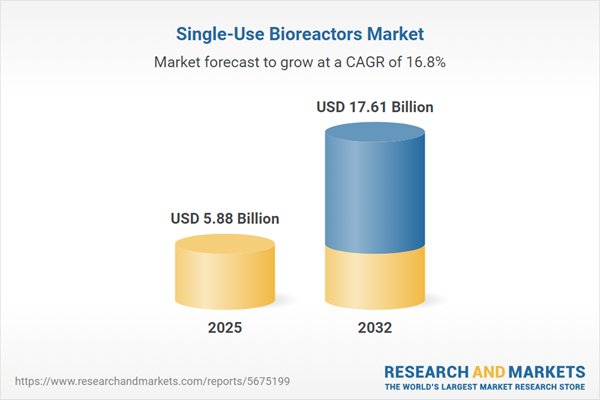Speak directly to the analyst to clarify any post sales queries you may have.
The single-use bioreactors market is rapidly redefining biopharmaceutical manufacturing through scalable, flexible, and efficient solutions built for modern process demands. This market overview highlights evolving supply chain strategies, digital integration, and regulatory considerations essential for senior decision-makers seeking competitive advantages in bioprocess optimization.
Market Snapshot: Single-Use Bioreactors Market Dynamics
The single-use bioreactors market grew from USD 5.08 billion in 2024 to USD 5.88 billion in 2025, and is projected to reach USD 17.61 billion by 2032, marking a CAGR of 16.81%. The sector’s upward trajectory is fueled by increasing biopharmaceutical investment, the acceleration of personalized therapeutics, and growing demand for adaptable, cost-effective manufacturing platforms. In this context, organizations are prioritizing modular and disposable systems that meet evolving process and compliance expectations while supporting new advances in therapeutic innovation.
Scope & Segmentation
- Bioreactor Types: Bubble-column, stirred-tank, and wave-induced bioreactors support diverse operational needs from gentle mixing for fragile cultures to robust agitation for large-scale production.
- Product Types: Includes filtration assemblies, media bags, and complete single-use bioreactor systems encompassing bags, sensors, and control units.
- Cell Types: Segmentation covers bacterial, mammalian, and yeast cells, enabling various applications such as monoclonal antibody manufacturing, enzyme production, and specialty bioproducts.
- Scale of Operations: Laboratory, pilot, and production-level bioreactors address the full spectrum of development, scale-up, and commercialization.
- Molecule Classes: Gene-modified cells, monoclonal antibodies, stem cells, and vaccines drive varied end-use cases across research and manufacturing.
- Applications: Bioproduction and research & development, serving evolving throughput and experimental needs.
- End-User Groups: Academic and research institutes, contract research and manufacturing organizations, and pharmaceutical and biopharmaceutical companies.
- Regions Covered: Americas (United States, Canada, Mexico, Brazil, Argentina, Chile, Colombia, Peru), Europe, Middle East, and Africa (including the United Kingdom, Germany, France, Russia, Saudi Arabia, South Africa, and others), and Asia-Pacific (China, India, Japan, Australia, South Korea, Indonesia, Thailand, Malaysia, Singapore, Taiwan).
- In-Depth Company Analysis: Profiles leading industry players such as ABEC, Sartorius AG, Thermo Fisher Scientific, Merck KGaA, Eppendorf, Cellexus Ltd., and others, outlining their product offerings, partnerships, and innovation strategies.
Key Takeaways for Senior Decision-Makers
- Single-use bioreactors enable rapid scale-up, minimize cross-contamination risk, and significantly reduce cleaning and validation efforts, offering streamlined batch transitions and faster time to market.
- Technological breakthroughs in materials science and process analytics support advanced process control, with digital twins and predictive modeling becoming integral to operational agility.
- Modular design and interoperability enhance plant flexibility, facilitating swift reconfiguration for varying production scales and supporting responsive, decentralized manufacturing strategies.
- Sustainability is addressed through innovations in recyclable and compostable materials, aligning with global regulatory shifts toward greener manufacturing and end-of-life waste management.
- Leading manufacturers drive competitive differentiation via targeted mergers, R&D investments, and digital service enhancements, responding to supply chain and regulatory challenges with robust strategies.
Tariff Impact and Supply Chain Adaptation
U.S. tariffs on key bioprocess materials such as polymer films and sensor components have prompted manufacturers to revisit sourcing, diversify supply chains, and qualify new suppliers—especially across Europe and Asia-Pacific. Organizations deploy bonded warehouses, renegotiate vendor agreements, and pursue tariff engineering, enhancing operational resilience amid trade policy uncertainty. This shift also fosters greater transparency, traceability, and cost control throughout the supply chain, ensuring robust risk management for end-users.
Methodology & Data Sources
This report applies a multi-stage research methodology, featuring primary interviews with process engineers, regulatory specialists, and executive stakeholders in biopharma and academia. Extensive secondary analysis incorporates technical literature, industry reports, and policy documents, with expert validation and data triangulation ensuring insight integrity and practical relevance for industry leaders.
Why This Report Matters
- Enables strategic alignment by uncovering technology, regulatory, and supplier dynamics shaping the future of single-use bioreactor adoption.
- Accelerates informed decisions with detailed segmentation, actionable recommendations, and benchmarking of leading market players.
- Supports competitive positioning by highlighting pathways to supply chain optimization and sustainability integration in bioprocessing operations.
Conclusion
This analysis empowers decision-makers to capitalize on transformative market shifts, improving operational agility and advancing innovation. Leveraging emerging technologies and diversified strategies can secure a robust foundation in the increasingly dynamic single-use bioreactors market.
Additional Product Information:
- Purchase of this report includes 1 year online access with quarterly updates.
- This report can be updated on request. Please contact our Customer Experience team using the Ask a Question widget on our website.
Table of Contents
3. Executive Summary
4. Market Overview
7. Cumulative Impact of Artificial Intelligence 2025
Companies Mentioned
The companies profiled in this Single-Use Bioreactors market report include:- ABEC, Inc.
- Broadley-James Corporation
- Cellexus Ltd.
- DH Life Sciences, LLC.
- Distek, Inc.
- Entegris, Inc.
- Eppendorf AG
- Esco Micro Pte. Ltd.
- Getinge AB
- Infors AG
- Meissner Corporation.
- Merck KGaA
- PBS Biotech, Inc.
- Pierre Guerin SAS
- Rentschler Biopharma SE
- Sartorius AG
- Sepragen Corporation
- Solaris Biotechnology Srl
- Solida Biotech GmbH
- Thermo Fisher Scientific Inc.
- VWR International, LLC.
Table Information
| Report Attribute | Details |
|---|---|
| No. of Pages | 193 |
| Published | November 2025 |
| Forecast Period | 2025 - 2032 |
| Estimated Market Value ( USD | $ 5.88 Billion |
| Forecasted Market Value ( USD | $ 17.61 Billion |
| Compound Annual Growth Rate | 16.8% |
| Regions Covered | Global |
| No. of Companies Mentioned | 22 |









